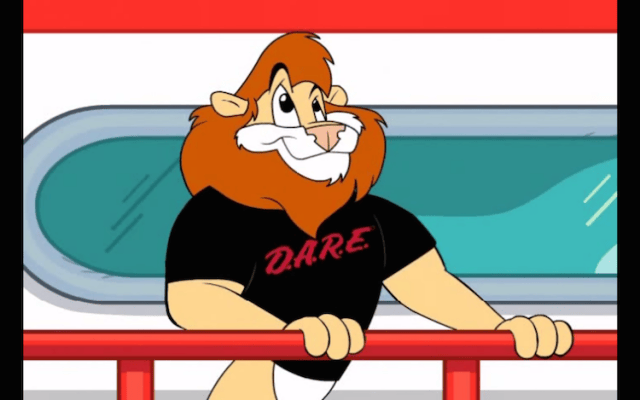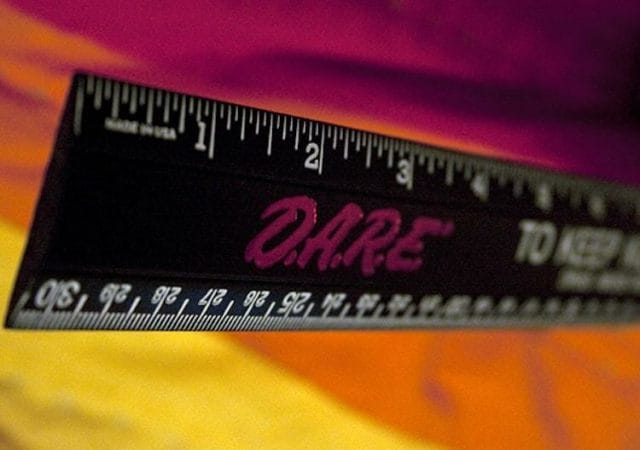
DARE, the popular drug education program, had no measurable effect on drug use. (me and the sysop)
If you went to grade school in the 1980s or 90s, chances are good you were publicly offered drugs at school by a uniformed police officer.
“Hey,” he might have said, “Want to meet up behind the gym after school and get high?”
Luckily for you, you were savvy enough to understand that this wasn’t an earnest offer. It was an exercise in resistance.
“No thanks!” you’d say. “I have homework to go do.”
“Come on,” he’d retort. Impressed with your delivery, he’d decided to step up the simulated peer pressure. “I thought you were cool.”
“Not doing drugs is cool,” was your reply.
Your classmates might have applauded, at the officer/teacher’s prompting. Then you went back to your seat, and the officer would go over the things you did well in the exercise, so the class could learn by your example. In addition to teaching the other students, the officer was also building up your self esteem.
Self esteem and resistance were two major cornerstones of the Drug Abuse Resistance Education Program, also known as DARE. Through the 1980s and the 1990s, DARE swelled from a tiny local program to a massive, and massively expensive, national campaign against drugs in schools. At its peak, DARE was practiced in 75% of American schools, and cost hundreds of millions of dollars to run. It had spiffy, 90s branded swag, and a baritone-voiced mascot, “Daren the Lion.”
There was just one problem: DARE didn’t work.
Students who went through DARE weren’t any less likely to do drugs than the students who didn’t. In fact, there’s some well-regarded research that some groups of students were actually more likely to do drugs if they went through DARE.
Scientists knew DARE was ineffective relatively early on, but the program grew anyways. The program’s eventual reform was the result of a long and hard battle between evidence-based research, and popular opinion.
DARE’s Humble Beginnings
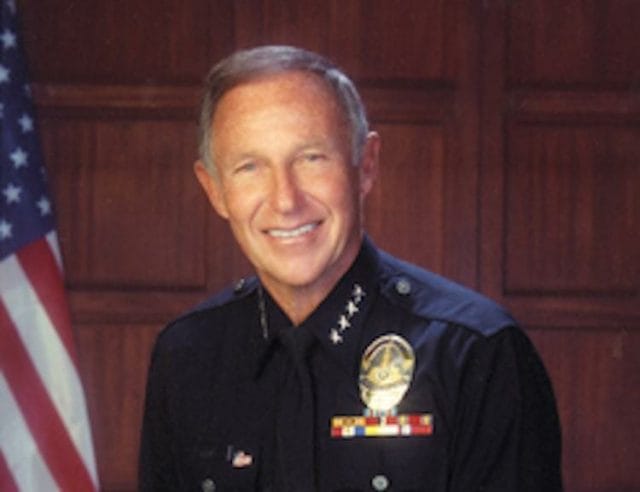
The original “Officer DARE”: DARE’s founder, LAPD Chief Daryl Gates, later became infamous for his handling of the Rodney King Riots
DARE got its beginnings in the city of Los Angeles in the early 1980s. Daryl Gates, the LA Police Department (LAPD) Chief of Police, helped create the program, and became its first figurehead. The story goes that when Gates noticed that the number of drug busts on school campuses was increasing, he had the idea to focus on preventative education instead of punishment. As Gates told the L.A. Times in 1993:
“We had ‘buy programs’ in the schools where undercover officers would buy drugs from students. We kept buying more and more. It was appalling, depressing. I finally said: ‘This is crazy. We’ve got to do something.’ “
The LAPD, in conjunction with the local rotary club and the LA Unified School District (LAUSD), came up with the Drug Abuse Resistance Education Program, DARE (also, incidentally, a pun with Chief Daryl Gates’ first name.)
Dr. Ruth Rich, the district’s health education specialist, was tasked with selecting the first curriculum. Research on drug prevention education was already underway at USC, under the title “SMART.” But there was a catch — Gates wanted DARE to be taught by police officers themselves, not doctors or teachers. Rich agreed with him, on the grounds that cops are more familiar with criminal culture. As she told the LA Times, “There’s a gap between the street and the classroom. Police officers are believable on this subject. When it comes to drugs, they’re more credible than a teacher.”
The idea of police officers in the classroom turned off some of SMART’s original authors, including the head of the research team, Andy Johnson. Reason Magazine reported, “Though sympathetic to Rich’s dilemma, Johnson had serious objections to handing an experimental educational program over to the local police.”
Without Johnson’s oversight, Rich took the SMART curriculum and patterned her own off of it. In 1993, there were two main versions of SMART: one that focused on developing personal goals and self esteem, and another that focused on resisting things like peer pressure and advertisements. Rich combined the two approaches.

A DARE course taught by Naval officers
When the school opened in September 1983, the LAPD took to the classroom to both teach kids about the dangers of substance abuse, boost their self-esteem, and help them practice “just saying no” (a la Nancy Reagan). Within a few years, DARE was a regular fixture in LA schools. By the mid-nineties, it was a national organization with multi-million dollar annual revenue.
The program was popular among parents and students from its inception. It was also popular among politicians and bureaucrats, who saw DARE as a way to be proactive about, “The Drug Problem.” From the Reason Magazine:
“[People were] eager to find an easy solution to the problem of juvenile drug abuse. DARE became ‘a rallying symbol to do something positive about the drug abuse problem.'”
This political status carried DARE far. In 1986, the National Institute of Justice (NIJ) published the first independent review of DARE, reporting that the program had short-term results. Although it drew criticism from the scientific community, DARE earned NIJ funding as a result of the study. DARE also soon won a $140,000 grant from the Department of Justice to expand the program to the national level. And Congress passed the “Drug-Free Schools and Communities Act of 1986,” which set aside 10% of State Grants to Governors for police-staffed, in-school, drug education programs, and mentions DARE by name.
Like that, DARE became a national, nationally funded movement. In 1988, U.S. presidents started recognizing National DARE Day, a practice that continued into the Obama administration. By 1992, the Drug-Free Schools and Communities Act money accounted for almost $10 million nationally. By 1995, DARE estimated its own costs at $200 million.
DARE vs. The Research, I
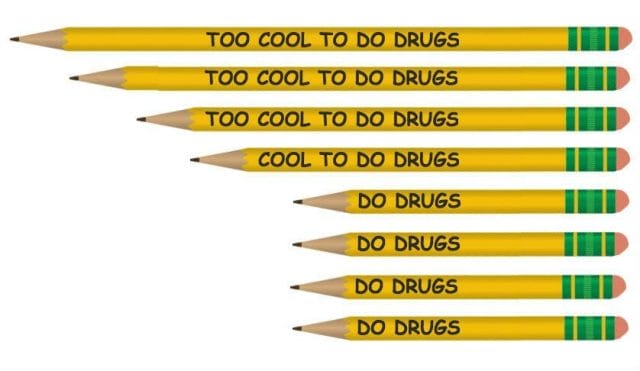
This pencil thing actually happened.
That first independent review of DARE, which found that it had an effect on drug use, quickly started to look like an extreme anomaly. By 1991 there were already more than a dozen published studies claiming that DARE had absolutely no measurable effect on drug use. This negative finding proceeded to bear out through another two decades of research.
This came as no surprise to the social scientists behind DARE’s original curriculum, the SMART program. A few years after DARE started, the USC researchers made an alarming discovery about SMART: early versions of the program didn’t work. In fact, some of them had a “boomerang effect,” by which participation correlated to higher rates of drug use. But by the time of this discovery, the LAUSD had grown “distant”, according to SMART researcher, Bill Hansen. Hansen and Johnson claim they reached out to DARE to help revise the curriculum, but were rejected.
“What they took was the prototype,” Hansen has said, “we went through thirty versions of the curriculum, so a lot of the stuff they lifted was antiquated, in our view.”
The problem was that, to a lot of people, it seemed like common sense that DARE would just work. “Everyone believed that if you just told students how harmful these substances and behaviors were—they’d stay away from them,” Frank Pegueros, the current president and CEO of DARE. America, has said.
This deep-seated, folksy belief in DARE’s ability to combat a publicly reviled problem gave it a decades-long stranglehold on the American education system. ”We suspect that there are gaping holes in the program and that it may not be cost-effective, but legislators are politicians,” a legislator told the New York Times in 2004, on the condition that his name not be used. ”No one’s going to risk their political future by doing anything other than standing up with the parents. Parents vote.”
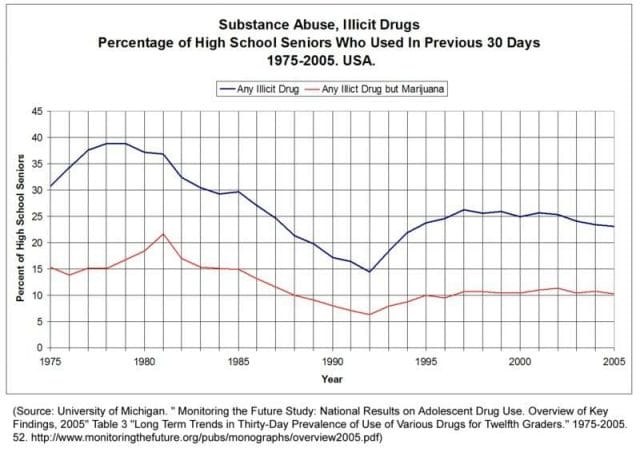
Drug use in high schools went down nationally in the 1980s and early 1990s. Some people who observed this trend in their local community might have misattributed it to DARE. (Via KruseKronicle)
Some of the battle between DARE and its scientific critics played out in public. Research was met with anecdotes, or with pleas that the program was changing too fast for studies of old curricula to be relevant, or that DARE was so widespread, its effects so particular, that it couldn’t be tested. “I don’t have any statistics for you. Our strongest numbers are the numbers that don’t show up,” a DARE official once told a newspaper. DARE supporters would regularly accuse critics of being in bed with drug cartels, or selfishly interested in taking over the drug resistance education industry. Negative media would inspire letters to the editor, supporting the program and calling for more funding.
DARE executives often pointed to the program’s popularity as evidence of its credibility. As Glenn Levant, the former LAPD officer who directed DARE in the early 1990s, told the LA Times in 1993, “Knocking DARE is like kicking your mother or saying that apple pie doesn’t taste good.”
He went on, “For 10 years, I’ve been living and breathing DARE, and it’s all been about helping kids. That’s our program, and that’s what we’re going to keep on doing.”
DARE vs. The Research, II

The NIJ commissioned a study from the prestigious Research Triangle Institute, and then refused to publish it
There was also a behind-the-scenes battle that played out between DARE and scientific research. While DARE was doing its best to publicly combat and distract the scientific naysayers, they also tried to silence critics before they reached the public spotlight at all.
In the early 90s, the NIJ hired the Research Triangle Institute (RTI) to do a meta-analysis of the existing evaluations of DARE’s efficacy. In 1994, RTI concluded the study, announcing that DARE had no measurable effect on drug use, and that other, existing programs, seem to do better. DARE could be improved, and if it refused to improve, it could be replaced. From the study’s conclusion:
“DARE’s limited influence on adolescent drug use behavior contrasts with the program’s popularity and prevalence. An important implication is that DARE could be taking the place of other, more beneficial drug use curricula that adolescents could be receiving.”
Then, despite positive peer review, and despite the fact that the NIJ had closely reviewed the study throughout its development, the NIJ refused to publish the results. They did not elaborate on their refusal, beyond claiming the work did not meet their, “high standards of methodological rigor.” The NIJ then issued a press release, reporting on the unpublished study, including the positive findings that DARE is popular, and growing, and omitting the claims of ineffectiveness.
“Not only is DARE widespread and popular, but demand for it is high,” it read. “[DARE’s] appeal cuts across racial, ethnic, and socioeconomic lines [with] considerable support for expansion of the program.”
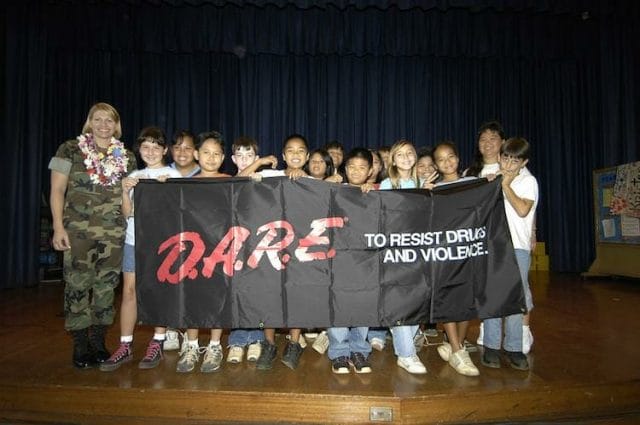
A DARE class in 2005 — 11 years after the RTI paper was published (Marion Doss)
When RTI sought publication in an independent journal — the American Journal of Public Health — DARE pressured the journal against publishing. The Journal’s editor, Sabine Beisler, told USA Today, “DARE has tried to interfere with the publication of this. They tried to intimidate us.” The paper, which flew through peer review, was published anyways.
The paper’s lead author commented on the fact that the concerns over methodological rigor were particularly problematic because the paper was a meta-analysis of existing research. RTI did not conduct any new experiments. As they told Reason:
“The results of all the studies used in the meta-analysis were consistent; it’s not like the conclusions of these different studies were all over the place. We did not find any support for [a statistically significant] impact on drug use, and they show DARE has no effect at all on marijuana use.”
When asked how the NIJ reviewers refused an article that the American Journal of Public Health reviewers “uniformly appraised” as “first-rate,” a DARE spokesperson told Reason, “It was hot and sexy for Public Health to criticize DARE.”
Makin’ it REAL
Hot and sexy or not, the RTI study was by no means the last to find DARE completely ineffective. No matter how researchers sliced it — by observing students exposed to more up-to-date versions of the curriculum, or who had taken DARE for multiple years — they could not find any evidence that DARE reduced drug use. There was some evidence that it temporarily improved students’ self-esteem, or gave them negative attitudes towards drugs. But there wasn’t any evidence that it actually had an effect on the behavior it was supposed to target.
But these reports themselves seemed ineffective at reaching the public in a meaningful way. Nor were they effective at slowing DARE’s growth. Then, nearly 20 years after DARE launched with a faulty curriculum, things started to change.
In 2000, the Department of Education did an audit of drug education programs. Only evidenced-based programs would be eligible for funding out of the Department of Education’s drug education budget. DARE did not make the cut.
In 2001, the Surgeon General did its own evaluation, concluding, “[D.A.R.E.’s] popularity persists despite numerous well-designed evaluations and meta-analyses that consistently show little or no deterrent effects on substance use.”

The flag of the Government Accountability Office
Then, in 2003, another government organization evaluated DARE. This time, it was the Government Accountability Office (GAO) — a federal watchdog on government spending of taxpayer money. GAO’s interest in DARE was obvious. DARE was funded with federal, state, and local taxes. In 2003, DARE’s cost was estimated at between $200 million and $2 billion.
GAO selected six long-term evaluations for review — studies that looked at kids 5 to 10 years after the DARE program and evaluated its effect. All of the studies found “no significant differences in illicit drug use,” between the DARE group and the control group. Five of the six reported on students attitudes towards drugs and found, “no significant differences between the [DARE] and control groups over the long term.”
Although GAO left the detail out of its report, some of the research it included in its review found that DARE had the dreaded “boomerang” effect on some students. As the authors of the original paper wrote, “Suburban students who were D.A.R.E. graduates scored higher than suburban students in the Control group on all four major drug use measures.”

The DARE money finally started to ebb. Cities and districts started shutting down their DARE programs — Rocky Anderson, as mayor of Salt Lake City, famously called the program a “fraud on the people of America.” Threatened with extinction, the shrinking DARE got serious about reforming itself into an evidenced-based practice. Suddenly, they needed and wanted the scientific community’s help.
“It was state of the art when we launched it,” Levant said in 2001, when he announced the planned curriculum overhaul. “Now it’s time for science to improve upon what we’re doing.”
It might have been too little, too late. By 2010, DARE’s revenue was $3.7 million, down from $10 million in 2002. It plunged into debt in 2009 and 2010.
***

keepin’ it REAL is DARE’s long-awaited answer to evidenced-based programming.
Today’s DARE promotes an education program that has a stamp of approval from the Substance Abuse and Mental Health Services Administration. The replacement program, titled “keepin’ it REAL,” launched in 2011. Its developers say it’s “not an anti-drug program,” but is more centered on decision-making skills, “things like being honest and safe and responsible.” But, unlike DARE, it’s been demonstrated in a handful of studies to reduce the risk of drug abuse:
“The reports from students who completed keepin’ it REAL indicated that they sampled these substances less than those in a control group, and used a wider variety of strategies to stay sober. Their antidrug attitudes were also more likely to stick over time.”
After two and a half decades of research, and the threat of extinction by defunding, DARE is finally friends with science. It’s been a long hard road, but America’s most popular drug resistance education program finally actually teaches kids to resist drugs.
***
For our next post, we investigate Donald Trump’s misadventures in professional football. To get notified when we post it → join our email list. A version of this article was originally published October 1, 2015.




